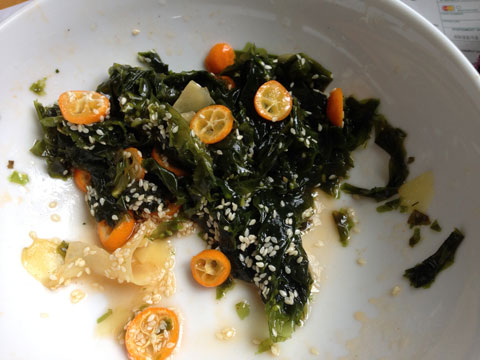
HOMEMADE SEAWEED SALAD Rehydrated Maine sea lettuce, with kumquat slices and a tangy dressing. |
Maine is at the forefront, in the US, of seaweed foraged wild and now cultivated. Maine Coast Sea Vegetables, headed by macrobiotic entrepreneur Shep Erhart, was the first American company to harvest and sell whole indigenous seaweeds, more than 40 years ago.
We even have a dedicated seaweed extension agent, Sarah Redmond, encouraging rope-cultured mussel farmers and lobsterman to try this counter-season winter crop. Redmond touts "integrated multi-trophic aquaculture," where farmed shellfish feed on the waste generated by salmon farms, and cultivated kelp then filters out remaining phosphorous and nitrogen, similar to land-based polyculture farms. Maine seafood promoter Monique Coombs thinks "seaweed will get really hot" here in the next few years. So dig in, with our Maine seaweed tasting guide:
KELPS Ocean Approved, the country's first kelp farm, sells blanched, frozen product, vibrant green and fresh upon defrosting. A tender "salad" cut is a local variety of wakame, good as-is in a seaweed salad with rice wine vinegar-tamari-sesame oil dressing and, added at the last minute, to miso soups and stir-fries. Ocean Approved also sells a chewier, thin "slaw cut" that's fresh horsetail kelp (Digitata laminaria). Finally, "noodle cut" ribbons of sugar kelp, akin to julienned green beans, are for salads and a gluten-free pasta substitute. At $4.69 for a four-ounce package (basically a single-serving), Ocean Approved's kelps are pricey. More concentrated, dried seaweeds cost a bit more per ounce, but include more servings when rehydrated. VitaminSea of Buxton and Maine Coast Sea Vegetables sell whole dried wild Atlantic kombu kelp, the base of the Japanese wonder-broth dashi so crucial to dipping sauces and ramen, and native wakame (Alaria) that's rather tough, with fibrous mid-ribs. Put a piece of dried kelp in a pot of baked beans, to reduce gas upon consumption.
NORI In the mid-'90s, an Eastport start-up tried to grow notoriously fickle nori (Porphyra) as a domestic source of sushi sheets — almost exclusively imported from Asia. Erhart also attempted — and failed — to press Maine's tough native Porphyra species into those elusive nori sheets. Now Maine Coast Sea Vegetables sources its organic, toasted wrappers from China. Erhart and VitaminSea still sell dried laver, a wild native nori cousin, with a similar sweet, nutty flavor, delicious as dry-roasted chips.
DULSE Bar patrons in the Canadian Maritimes and Ireland have long snacked on this flavorful, red seaweed, pan-fried into crispy chips. Make your own in a well-oiled cast iron skillet, with the dried dulse Larch "The Seaweedman" Hanson forages from Gouldsboro Bay (or from VitaminSea or Maine Coast, which says dulse is its top-seller). Combine with laver and also tender SEA LETTUCE (the salad green of the sea vegetable world; available locally) for a tri-colored, fresh seaweed salad instead of the neon-green, dyed stuff.
IRISH MOSS FMC BioPolymer (the erstwhile Marine Colloids) in Rockland has long processed this seaweed into the food additive carrageenan, commonly found in toothpaste and ice cream. The New Yorker's Katharine S. White, a North Brooklin resident, wrote in 1965 of her childhood detest of that gelled pudding dessert, Irish-moss blancmange. After all, seaweed extracts, including agar-agar, are a vegan source of "gelatin."